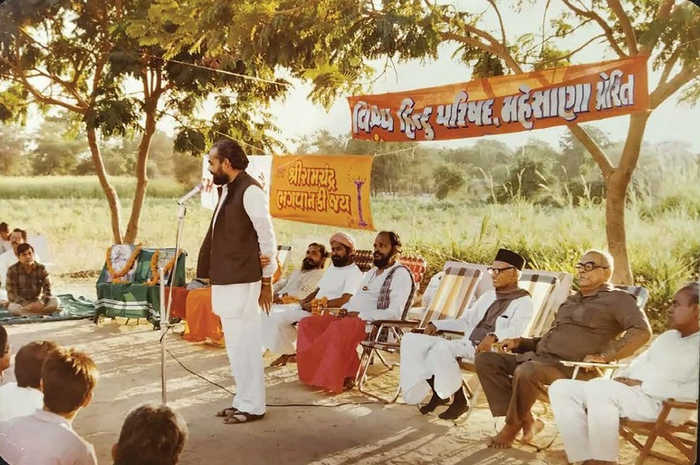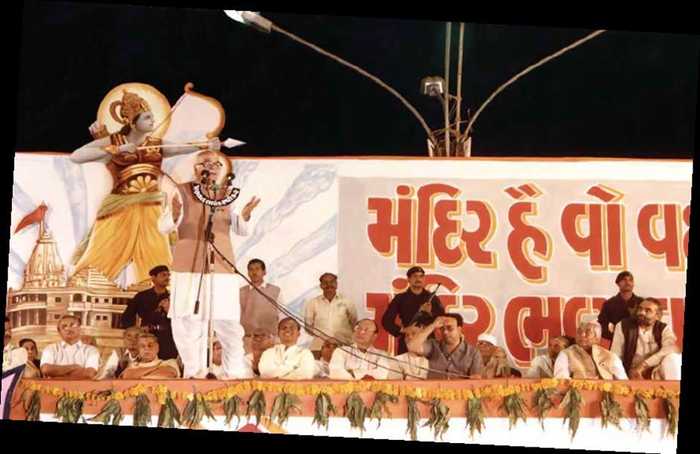Published 00:26 IST, December 31st 2023
Republic takes a look back at the decades-long journey of PM Modi -- of turning the long-drawn dream of Ram Mandir establishment in Ayodhya -- into a reality
Advertisement
NEW DELHI: As the nation celebrates the inauguration of the newly-built international airport and railway station in the holy city of Ayodhya on Saturday, 30 December, Republic takes a look back at the decades-long journey of Prime Minister Narendra Modi, of turning the long-drawn dream of Ram Mandir establishment in Ayodhya, into a reality.
'No power in world can stop Ram temple from being built'
In the centuries-long struggle for the establishment of the Ram Mandir in Ayodhya – the birthplace of Hindu God Lord Ram, PM Modi – in his nearly a decade-long tenure of being at the helm of the country's affairs – eventually did live up to his words of building the temple “at the site of Ram Janmabhoomi only”.
Advertisement
Archives of audio extracts from the 'Lok Adalat Ma Ayodhya' suggest that thousands of copies of cassettes – of PM Modi's powerful speeches during the Ram Janmabhoomi movement– are a testament to how the very essence of this movement - a very first step in the direction – resonated with the general public at a much-deeper level.
“The Ram Mandir shall be built at the site of Ram Janmabhoomi only, the place where Ram was born. No power in the world can stop the Ram temple from being built,” an account on ‘X’ (formerly known as Twitter), by the name of Modi Archive, suggests. The ‘Modi Archive’ account gives a peek into PM Modi's life journey via archives of pictures, videos, audio recordings, letters and newspaper clips.
Advertisement
Yatras across India for ‘awakening & revivalism’
Identifying himself as a swayamsevak at the Hindu nationalist organization Rashtriya Swayamsevak Sangh (RSS), Modi – with his involvement spanning nearly six decades – played a pivotal role in the Ram Janmabhoomi movement.
During the course of his journey for the movement that dates back to the 1970s, Modi conducted several “yatras” (roadshows) across the length and breadth of the country “for awakening and revivalism”, with his focus essentially revolving around “reclaiming” Lord Ram's birthplace in Ayodhya as a “swayamsevak in the RSS”.
Advertisement
Advertisement

Ram-Shila ‘a symbol of national consciousness’
A post from the Modi Archive account on ‘X’ suggests that Modi had, in an article for Sadhana magazine in 1989, written about his vision for the Ram Mandir construction, and its subsequent “contribution to awakening [the] national consciousness and uniting India”.
Asserting that the significance of ‘Ramshila’ extended beyond the construction of Ram temple, Modi reportedly wrote in the magazine: “The Ramshila has become a symbol of national consciousness, and those opposing the cause may feel uneasy”.
Advertisement
Further in the article, Modi evoked the fervour around Lokmanya Tilak's Ganeshotsav, reflecting on how the event had “nurtured national consciousness during the freedom movement”. He then went on to cite Mahatma Gandhi's charkha as a reference point to highlight how the ‘Swarajya with Charkha’ movement, going beyond economic support, had “created a world of devotional sentiments”.
Drawing parallels with both the movements, Modi mentioned “in the fifth decade of independence, Ramshila has become the foundation stone of national consciousness”.
'Naye Bharat Ki Nayi Ayodhya'
To build a united and future-oriented nation, "there is a need to reconstruct those symbols that connect hearts, not those that break them”, Modi had written for the magazine.
Terming the then-impending reconstruction of Ram Janmabhoomi “a symbol of [the message] of unity” that was a result of gradually dissolving “hatred”, Modi stressed that it was the need of the hour to religiously follow Tulsidas's remarks: "Ram kaaj karibe ko aatur (and not ‘Raj-Kaaj’), more than ever.

The article in the Sadhana magazine, published in the 19th century, then concluded with heaps of praise for Narendra Modi, under whose charismatic leadership, India was "witnessing the realization of this (reconstruction of Ram Janmabhoomi) vision with 'Naye Bharat ki Nayi Ayodhya'.
‘Collecting pieces of bricks from villagers across Gujarat’
As per the archives, Narendra Modi, in collaboration with the Vishwa Hindu Parishad (VHP) – another organization with its ethos deeply-rooted in Hindu nationalism – actively contributed during the Ram Shila Pujan ceremony held in 1989. During this period, he reportedly went on a tour across various villages in Gujarat with the aim of “collecting pieces of bricks from thousands of villagers”.

When Modi ate nothing, sustained on water during yatra through 600 villages
In September 1990, the then Gujarat BJP General Secretary Narendra Modi, played a crucial role as the charioteer for the Gujarat-leg of the Somnath-Ayodhya Ram Rath Yatra. Modi, who was – at the time – bestowed with the responsibility of overseeing the entire journey, took charge during the Navratra season, and reportedly exhibited “remarkable dedication”.
Interestingly, Modi ate nothing and sustained himself solely on water throughout the journey that spanned 600 villages in the state of Gujarat.

When Modi's work ethic moved Advani's wife to tears
Reports from the archives suggest that Modi favoured a “grand and successful initiation” since the very beginning of the yatra, and that he “believed it would dispel any doubts or questions” that could've potentially been raised about the yatra's success.
Noteworthily, the daily-routine of the Somnath-Ayodhya Yatra, according to reports, demanded rigorous workdays that often times extended up to 18 hours a day.

Modi's “relentless” work ethic reportedly moved LK Advani's wife, Kamala Advani, to tears, following which he was “advised to take rest”. Responding to the concerns around his well-being, Modi expressed his “intense commitment”, saying it was “his true calling”.
“This is my real life, and I enjoy it”, he had reportedly emphasized.
15:34 IST, December 30th 2023